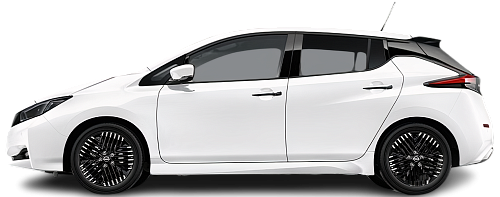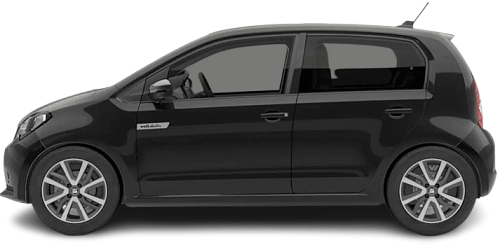Global EV Comparison: Nissan Leaf 40 kWh vs Seat Mii Electric
Struggling to Decide? Let AI Help!
Your AI Summary Is Ready!
General Info
Since both vehicles have been discontinued, they are now only available on the used car market. You can get the Nissan Leaf 40 kWh (2022-2025) for as low as €15890, while the Seat Mii Electric (2019-2021) begins at €11390.
The two vehicles share the same body style: Hatchback.
| Property | Nissan Leaf 40 kWh | Seat Mii Electric |
|---|---|---|
| Years of Production | 2022-2025 | 2019-2021 |
| Current Status | Discontinued | Discontinued |
| Country of Manufacture | Japan, UK, USA | Slovakia |
| Body Style | Hatchback | Hatchback |
| Market Availability | EU, USA | EU |
| Price Europe (Used) | €15890 | €11390 |
| GCC Score | 4.8 | 4.5 |
Range and Efficiency
While the Nissan Leaf 40 kWh (2022-2025) offers a longer real-world range and a bigger battery, it is less energy-efficient than the Seat Mii Electric (2019-2021).
| Property | Nissan Leaf 40 kWh | Seat Mii Electric |
|---|---|---|
| Range (EPA) | 240 km | - Range (EPA) |
| Range (WLTP) | 285 km | 259 km |
| Range (GCC) | 238 km | 223 km |
| Battery Capacity (Nominal) | 40 kWh | 36.8 kWh |
| Battery Capacity (Usable) | 39 kWh | 32.3 kWh |
| Efficiency per 100 km | 16.4 kWh/100 km | 14.5 kWh/100 km |
| Efficiency per kWh | 6.1 km/kWh | 6.9 km/kWh |
| Range and Efficiency Score | 5.6 | 6.1 |
Charging
Both vehicles utilize a standard 400-volt architecture.
The Nissan Leaf 40 kWh (2022-2025) offers faster charging speeds at DC stations, reaching up to 50 kW, while the Seat Mii Electric (2019-2021) maxes out at 40 kW.
The Seat Mii Electric (2019-2021) features a more powerful on-board charger, supporting a maximum AC charging power of 7.2 kW, whereas the Nissan Leaf 40 kWh (2022-2025) is limited to 3.6 kW.
| Property | Nissan Leaf 40 kWh | Seat Mii Electric |
|---|---|---|
| Max Charging Power (AC) | 3.6 kW | 7.2 kW |
| Max Charging Power (DC) | 50 kW | 40 kW |
| Architecture | 400 V | 400 V |
| Charge Port | CHAdeMO | CCS Type 2 |
| Charging Score | 3.3 | 3.9 |
Performance
Both vehicles are front-wheel drive.
The Nissan Leaf 40 kWh (2022-2025) boasts greater motor power and accelerates faster from 0 to 100 km/h.
| Property | Nissan Leaf 40 kWh | Seat Mii Electric |
|---|---|---|
| Drive Type | FWD | FWD |
| Motor Type | PMSM | PMSM |
| Motor Power (kW) | 110 kW | 61 kW |
| Motor Power (hp) | 148 hp | 82 hp |
| Motor Torque | 320 Nm | 212 Nm |
| 0-100 km/h | 7.9 s | 12.3 s |
| Top Speed | 144 km/h | 130 km/h |
| Performance Score | 3 | 1.7 |
Dimensions
The Nissan Leaf 40 kWh (2022-2025) is longer, wider, and taller.
The Nissan Leaf 40 kWh (2022-2025) boasts a more extended wheelbase.
| Property | Nissan Leaf 40 kWh | Seat Mii Electric |
|---|---|---|
| Length | 4490 mm | 3556 mm |
| Width (with Mirrors) | 2030 mm | - Width (with Mirrors) |
| Width (w/o Mirrors) | 1788 mm | 1645 mm |
| Height | 1530 mm | 1481 mm |
| Wheelbase | 2700 mm | 2421 mm |
Cargo and Towing
The Nissan Leaf 40 kWh (2022-2025) provides more cargo capacity, featuring both a larger trunk and more space with the rear seats folded.
Neither car is equipped with a frunk (front trunk).
Neither vehicle is officially rated for towing in in the EU.
| Property | Nissan Leaf 40 kWh | Seat Mii Electric |
|---|---|---|
| Number of Seats | 5 | 4 |
| Curb Weight | 1580 kg | 1235 kg |
| Cargo Volume (Trunk) | 435 l | 251 l |
| Cargo Volume (Max) | 1176 l | 923 l |
| Cargo Volume (Frunk) | - Cargo Volume (Frunk) | - Cargo Volume (Frunk) |
| Towing Capacity | - Towing Capacity | - Towing Capacity |
| Cargo and Towing Score | 4.5 | 3.6 |




